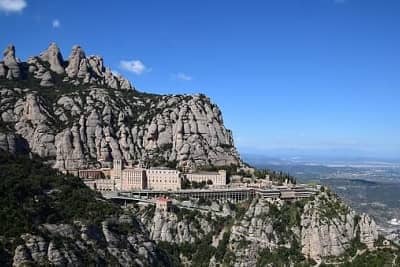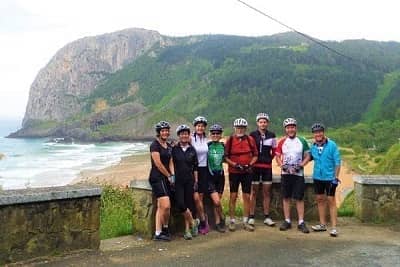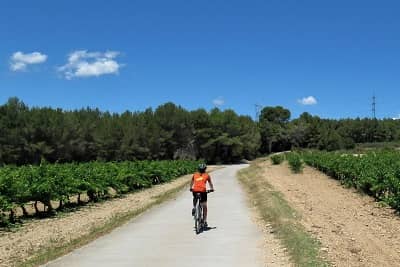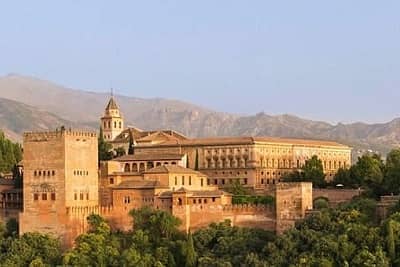A Short Guide to Cycling Hills
On some of our leisurely cycling holidays there are some short hills which riders often fear. If you are not used to it, then climbing hills on
a bike can seem a bit daunting, even if they are only one or two miles long. But reaching the top of a mountain or is one of the most rewarding feelings in cycling.
When cyclists look to avoid hills they miss out on this feeling, as well as the superb views that you get near the summit of a climb. In this short guide, we give a few tips to make climbing more enjoyable. This is not about how to go as fast as possible or climbg high mountains, but rather, about why you shouldn't fear a few short climbs on a leisurely cycling tour.
There are many great reasons to embrace the climbs and enjoy them. First of all, you get the best views with a bit of elevation. Mountain scenery with unobstructed views for many miles around is one of the great pleasures of cycling, but even a short climb can provide wonderful views looking back down from where you have come.
Particularly in Europe, many of the most interesting historic villages and castles are also situated on the top of small hills, where they could be defended more easily against attack!
Climbing hills is also rerwarding; there is a real sense of achievement in reaching the top of a climb It gets the endorphins flowing through the body and is a great form of exercise.
Finally, from the top of the hill you also get the fun and sometimes exhilirating descents. Whether you choose to take it slowly and admire the views, or let the brakes go and enjoy the speed, a great descent is certainly one of the highlights of riding a bike.
The first tip is to use the gears on your bike. Now, that sounds a pretty obvious comment to make, so let us expand a little.
Modern bicycles today, whether road, hybrid or mountain bikes, all have a huge range of gears, which makes climbing significantly easier than it was a few decades ago. And finding the right gear for a climb makes things much more comfortable.
If your gear is too hard then you may end up turning the pedals very slowly, which can cause the leg muscles to fatigue quickly. Instead, you want to be able to spin the pedals at quite a reasonable speed. Instead of trying to power up the climb with your legs, let your heart and lungs do most of the work!
At the same time, try not to use a gear which is too easy. This will make it difficult to pedal smoothly, and can lead you to go too slowly. It is best to climb at the fastest speed that you can maintain comfortably. By keeping a bit of speed, you maintain momentum and inertia which helps to keep the tyres rolling.
Don't be afraid to change gears on the climb. Climbs are rarely a consistent gradient, throughout and so it's necessary to change gears to match the different slopes, so that you can keep the same rhythm.
Also don't fall into the trap of 'saving a gear for later'. We have heard this several times, that riders don't want to use their highest gear because they are afraid they will need it later when they get more tired.
This might have some psychological benefit, but on a practical level, it's probably not helping. If your highest gear is the one that allows you to maintain the most comfortable rhythm; then use it! Even if it is at the very start of the climb.
Breathing heavily is fine and normal, but ideally it should be controlled, you don't want to be gasping for breath - which indicates that you have pushed a bit too hard.
At times, particularly on steeper sections, it is inevitable that your breathing might becoming a bit less controlled. When it does, don't be afraid to pull over and stop for a brief rest, or at least to slow down to let your heart rate come down once you reach a flatter section.
On our guided cycling holidays, riders are sometimes worried that they are holding up the rest of the group by doing this. Don't be. We know that climbing hills can be challenging and it's perfectly normal for some riders to stop or go at a very steady pace.
Keep you breathing under control and you will probably get to the top more quickly than if you push too hard and will be forced to stop and recover for longer anyway.
One important tip is to keep your hands and upper body as relaxed as possible. It's quite common when climbing for riders to grip the handlebars very tightly, and perhaps even to rock their upper body to produce a bit of extra power.
We don't recommend doing that. It's something that's useful for competitive cyclists who are looking to get every possible advantage, but on a cycling holiday it's unnecessary and also can lead to back issues if you push it too far.
Standing on the pedals every few minutes is a good option if you are comfortable doing so. It recruits the leg muscles slightly differently than when sitting and so can relieve some of the lactic acid building up. And, perhaps more importantly, it also relieves pressure on the saddle area, which can build up particularly on slightly longer ascents.
If you aren't comfortable standing on a bike then, again, you can achieve the same benefits by briefly stopping and taking a rest for 30 seconds by the side of the road.
Some riders like to break up climbs into short sections as a form of motivations. You can focus on making to a certain tree or building and, once you are there, you will probably feel fine to continue to the next landmark you choose. But breaking up the climb in this way can make it seem less daunting, if you are worried about how long it is.
Remember as well that even riders who love riding in the mountains have times when they really struggle on climbs and are desperate for them to end. There's nothing wrong with that, and it doesn't mean that climbing is not for you.
Most of all though, remember to focus on what is around you. Enjoy the views, the nature and the tranquility of a climb. Enjoy the achievement and that you are accomplishing something. And you can even focus on all those calories you are burning, and how you'll be able to treat yourself to a fantastic lunch!
Well, if you are riding in high mountains and tackling climbs which may take one or two hours of riding, then yes, nutrition is extremely important. But that is kind of beyond the scope of this article.
On more leisurely tours where the longer climbs tend to be a couple of miles or so, nutrition really isn't that important. Of course, you need to have eaten, but there isn't really any need to be drinking sports drinks or chomping on gels and other pure sugar supplements.
Try not to get too hung up on it though, on more leisurely cycling holidays, your nutrition is unlikely to be a seriously limiting factor for your climbing. Just don't try to diet while on your tour! You will probably lose weight on a cycling holiday even if you eat everything you like - trying to get by on just salads may make the climbs feel a bit harder than they should be.
More important than your nutrition, is drinking. Particularly if you are cycling in a hot climate. You can sweat a lot on climbs, particularly because you don't have the cooling breeze that is common when riding at higher speeds.
Make sure that you drink regularly; we recommend taking sips of water every five or ten minutes. Adding electrolytes (salt tablets) to your water can also help to limit dehydration. This generally isn't necessary, but if you find yourself getting a bit lightheaded or having some minor cramping issues, they may help.
Just eating normal food is fine. Have whatever you want for dinner the night before and eat a good breakfast and you will be fine for routes that take two hours or so. When they are longer, it is useful to snack on something - whether it be fruit, chocolate, granola bars, or a nice slice of cake at the coffee stop!
Most of all, enjoy climbs rather than fearing or avoiding them. They are an integral part of cycling and can really enhance the experiences you get by riding a bike.
If, after reading these tips, you are still not convinced, another option is to consider an e-bike. They can give you assistance on the climbs, which can be dialled in to give you more or less help depending on how you feel. All of the tips above still apply when you are on an e-bike, but it can just give you that bit of insurance if your are still concerned about the climbs.
When cyclists look to avoid hills they miss out on this feeling, as well as the superb views that you get near the summit of a climb. In this short guide, we give a few tips to make climbing more enjoyable. This is not about how to go as fast as possible or climbg high mountains, but rather, about why you shouldn't fear a few short climbs on a leisurely cycling tour.
Why Bother Climbing?
It's possible to avoid climbs when you cycle, particularly if you live in a flat area. But if you looking to go on a cycling holiday, then we urge you not to rule out a destination simply because it has one or two inclines!There are many great reasons to embrace the climbs and enjoy them. First of all, you get the best views with a bit of elevation. Mountain scenery with unobstructed views for many miles around is one of the great pleasures of cycling, but even a short climb can provide wonderful views looking back down from where you have come.
Particularly in Europe, many of the most interesting historic villages and castles are also situated on the top of small hills, where they could be defended more easily against attack!
Climbing hills is also rerwarding; there is a real sense of achievement in reaching the top of a climb It gets the endorphins flowing through the body and is a great form of exercise.
Finally, from the top of the hill you also get the fun and sometimes exhilirating descents. Whether you choose to take it slowly and admire the views, or let the brakes go and enjoy the speed, a great descent is certainly one of the highlights of riding a bike.
How to Climb Hills
There is nothing too mysterious or complicated about climbing hills. If you listen to professional cyclists or trainers, they will talk about complicated topics like threshold power and optimal pacing. But for more leisurely riders, a lot of that is unneccesary. Instead, there are just a few simple things to focus on which can help you enjoy climbing more.The first tip is to use the gears on your bike. Now, that sounds a pretty obvious comment to make, so let us expand a little.
Modern bicycles today, whether road, hybrid or mountain bikes, all have a huge range of gears, which makes climbing significantly easier than it was a few decades ago. And finding the right gear for a climb makes things much more comfortable.
If your gear is too hard then you may end up turning the pedals very slowly, which can cause the leg muscles to fatigue quickly. Instead, you want to be able to spin the pedals at quite a reasonable speed. Instead of trying to power up the climb with your legs, let your heart and lungs do most of the work!
At the same time, try not to use a gear which is too easy. This will make it difficult to pedal smoothly, and can lead you to go too slowly. It is best to climb at the fastest speed that you can maintain comfortably. By keeping a bit of speed, you maintain momentum and inertia which helps to keep the tyres rolling.
Don't be afraid to change gears on the climb. Climbs are rarely a consistent gradient, throughout and so it's necessary to change gears to match the different slopes, so that you can keep the same rhythm.
Also don't fall into the trap of 'saving a gear for later'. We have heard this several times, that riders don't want to use their highest gear because they are afraid they will need it later when they get more tired.
This might have some psychological benefit, but on a practical level, it's probably not helping. If your highest gear is the one that allows you to maintain the most comfortable rhythm; then use it! Even if it is at the very start of the climb.
Breathing when Climbing
Somewhat related to the use of gears is breathing. Try to keep your breathing under control when climbing. Again, this is about maintaining a comfortable and consistent rhythm from the bottom to the top of the climb.Breathing heavily is fine and normal, but ideally it should be controlled, you don't want to be gasping for breath - which indicates that you have pushed a bit too hard.
At times, particularly on steeper sections, it is inevitable that your breathing might becoming a bit less controlled. When it does, don't be afraid to pull over and stop for a brief rest, or at least to slow down to let your heart rate come down once you reach a flatter section.
On our guided cycling holidays, riders are sometimes worried that they are holding up the rest of the group by doing this. Don't be. We know that climbing hills can be challenging and it's perfectly normal for some riders to stop or go at a very steady pace.
Keep you breathing under control and you will probably get to the top more quickly than if you push too hard and will be forced to stop and recover for longer anyway.
Body Position when Climbing
There isn't really a right or wrong way to sit on a bike when climbing. Again, it's about remaining comfortable as much as possible.One important tip is to keep your hands and upper body as relaxed as possible. It's quite common when climbing for riders to grip the handlebars very tightly, and perhaps even to rock their upper body to produce a bit of extra power.
We don't recommend doing that. It's something that's useful for competitive cyclists who are looking to get every possible advantage, but on a cycling holiday it's unnecessary and also can lead to back issues if you push it too far.
Standing on the pedals every few minutes is a good option if you are comfortable doing so. It recruits the leg muscles slightly differently than when sitting and so can relieve some of the lactic acid building up. And, perhaps more importantly, it also relieves pressure on the saddle area, which can build up particularly on slightly longer ascents.
If you aren't comfortable standing on a bike then, again, you can achieve the same benefits by briefly stopping and taking a rest for 30 seconds by the side of the road.
The Mentality of Climbing
Climbing hills is part physical and part psychological. It's useful to maintain a positive mindset. Don't be afraid of the climb, and remember that having to briefly stop or even walk a steep section is not a sign of weakness, but rather part of the strategy to enjoy the ride. Which, after all, is the whole point of cycling for most of us!Some riders like to break up climbs into short sections as a form of motivations. You can focus on making to a certain tree or building and, once you are there, you will probably feel fine to continue to the next landmark you choose. But breaking up the climb in this way can make it seem less daunting, if you are worried about how long it is.
Remember as well that even riders who love riding in the mountains have times when they really struggle on climbs and are desperate for them to end. There's nothing wrong with that, and it doesn't mean that climbing is not for you.
Most of all though, remember to focus on what is around you. Enjoy the views, the nature and the tranquility of a climb. Enjoy the achievement and that you are accomplishing something. And you can even focus on all those calories you are burning, and how you'll be able to treat yourself to a fantastic lunch!
Eating and Drinking on a Climb
Speaking of food, what exactly should you do about nutrition on a climb? You have probably heard cyclists and trainers repeatedly emphasize how important it is to have eaten lots of carbohydrates and maybe even to have been planning specific meals the night before. So, is this important?Well, if you are riding in high mountains and tackling climbs which may take one or two hours of riding, then yes, nutrition is extremely important. But that is kind of beyond the scope of this article.
On more leisurely tours where the longer climbs tend to be a couple of miles or so, nutrition really isn't that important. Of course, you need to have eaten, but there isn't really any need to be drinking sports drinks or chomping on gels and other pure sugar supplements.
Try not to get too hung up on it though, on more leisurely cycling holidays, your nutrition is unlikely to be a seriously limiting factor for your climbing. Just don't try to diet while on your tour! You will probably lose weight on a cycling holiday even if you eat everything you like - trying to get by on just salads may make the climbs feel a bit harder than they should be.
More important than your nutrition, is drinking. Particularly if you are cycling in a hot climate. You can sweat a lot on climbs, particularly because you don't have the cooling breeze that is common when riding at higher speeds.
Make sure that you drink regularly; we recommend taking sips of water every five or ten minutes. Adding electrolytes (salt tablets) to your water can also help to limit dehydration. This generally isn't necessary, but if you find yourself getting a bit lightheaded or having some minor cramping issues, they may help.
Just eating normal food is fine. Have whatever you want for dinner the night before and eat a good breakfast and you will be fine for routes that take two hours or so. When they are longer, it is useful to snack on something - whether it be fruit, chocolate, granola bars, or a nice slice of cake at the coffee stop!
Summary
So, overall, there is nothing really revolutionary that we are suggesting here for climbing hills. Just try to stay comfortable and ride at a sustainable pace, using your gears when necessary. Don't try to power up them to get them over with as quickly as possible, and don't get too hung up on nutrition and things like body positioning.Most of all, enjoy climbs rather than fearing or avoiding them. They are an integral part of cycling and can really enhance the experiences you get by riding a bike.
If, after reading these tips, you are still not convinced, another option is to consider an e-bike. They can give you assistance on the climbs, which can be dialled in to give you more or less help depending on how you feel. All of the tips above still apply when you are on an e-bike, but it can just give you that bit of insurance if your are still concerned about the climbs.
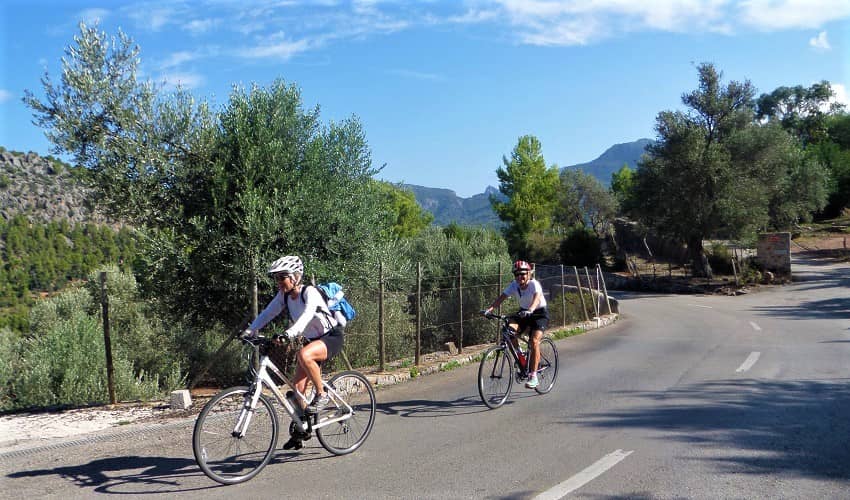
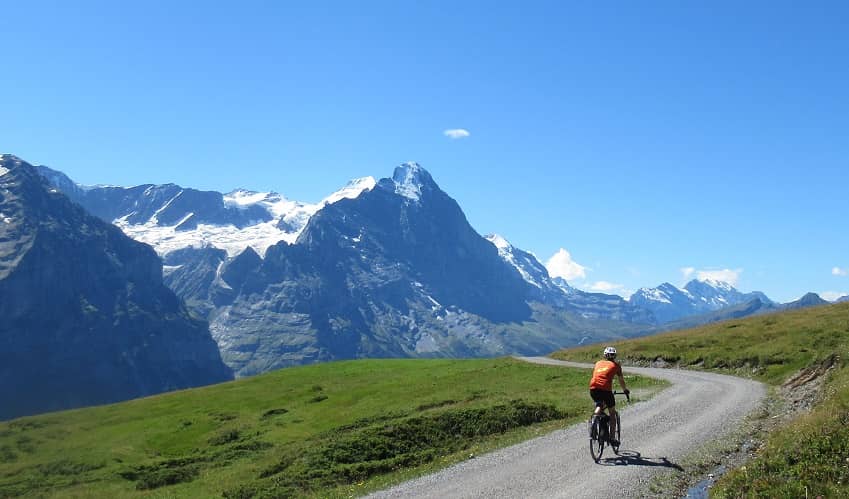
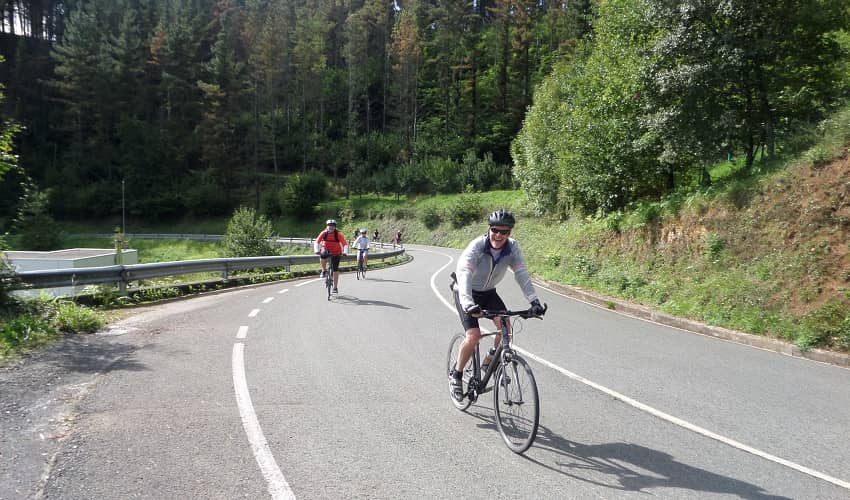
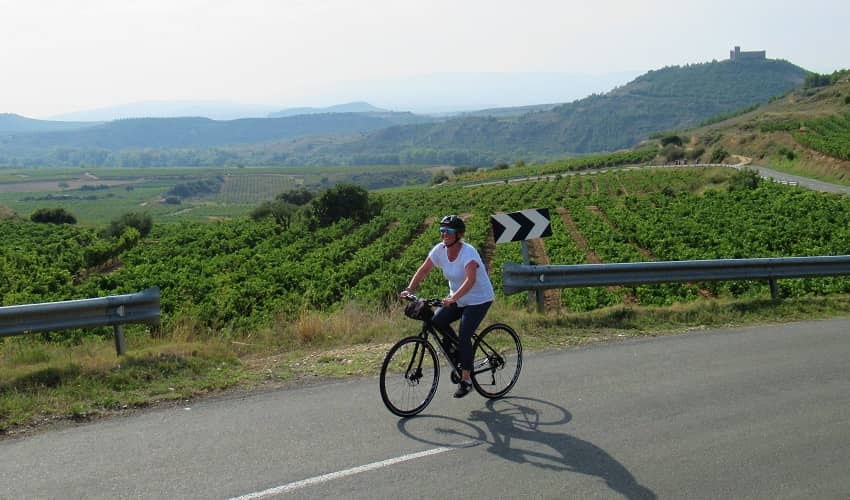
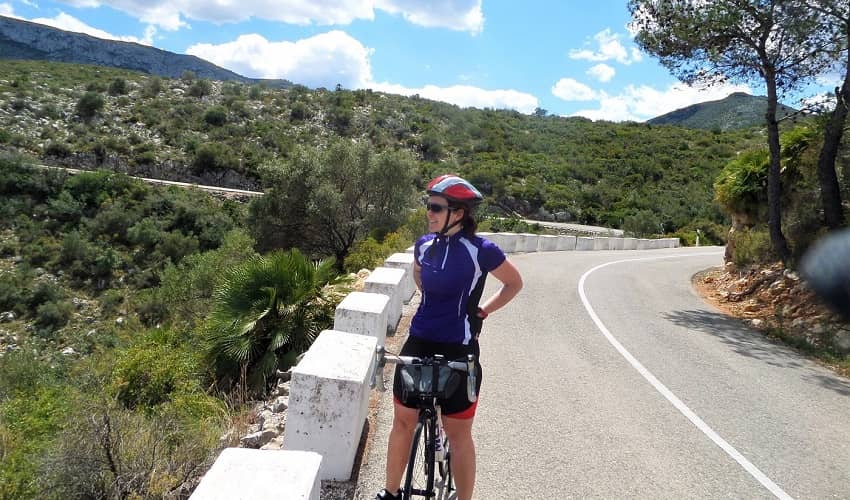
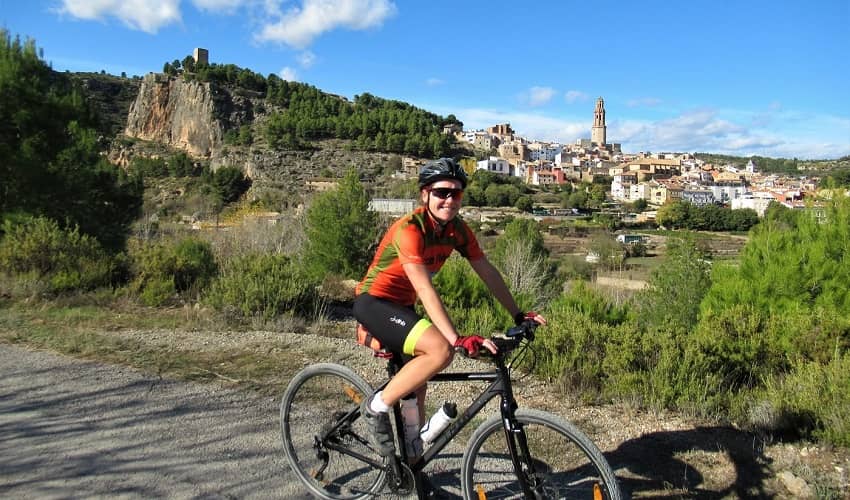
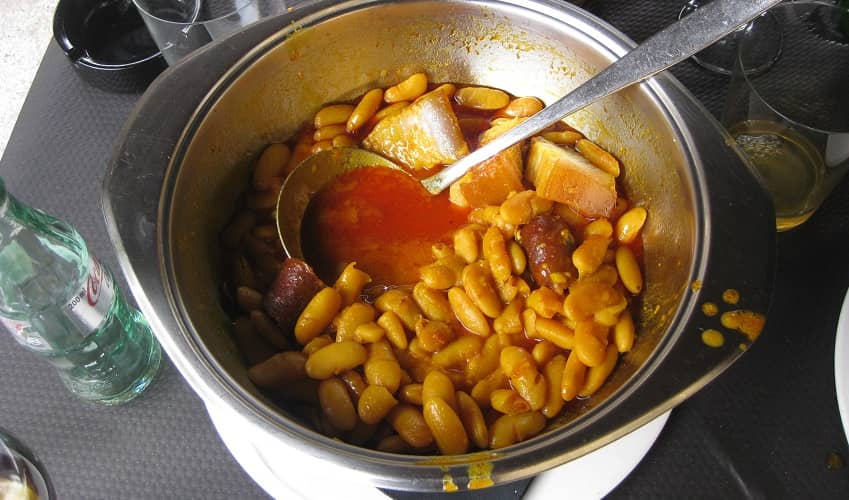
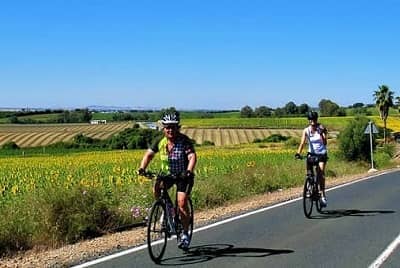
 Spain
Spain
